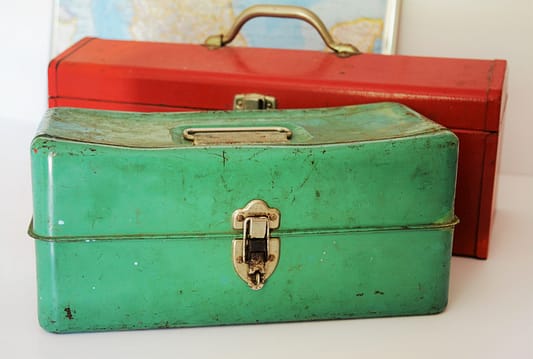How to Build a Coping Kit

You’re out at the store, and suddenly you notice your heart is racing. You’re out in public, and about to have a panic attack! What do you do?
Have a Plan in Advance
We all have tools in our mental toolbox that can help us get through a tough moment, whether its at home or in public. But in the moment of panic, it can be hard to remember what they are.
As a teenager, I couldn’t understand why it would never occur to me to take slow, deep breaths when I was upset. When I was calm it was easy to do! But in the moment, I couldn’t remember my skill. It took a lot of practice to be able to use it in the moment that it could be most useful.
When we’re distressed, our body decreases the communication with the frontal lobe of our brain. That’s where our the ability to think, plan, make decisions and think logically about the future lives. But during a crisis, our body prioritizes reacting instinctively and by reflex.
You don’t want to spend time mentally debating if you should pull your hand off the hot stove, you want to do it as fast as possible. Unfortunately, in non-life-threatening situations, our survival response can get in the way of effective coping.
So if you want to be as effective as possible, you need to do your thinking and planning in a moment of calm, before your thinking brain gets hijacked by your reflexes. My favorite strategy for this is building a coping kit.
A coping kit is a collection of ideas that you can use when stressed to get through a tough moment. Let’s talk about the kind of skills you want in your kit.
Types of Coping Skills You Need in Your Kit
To make your kit as useful as possible you want to have strategies for use when:
- You are at home or in public
- You are alone or interacting with others
- Are focused on your internal and external experiences
Skills for use at Home and in Public
It is important to have coping skills that you are comfortable doing and fit your current situation. While at home I may be willing to jump around and sing along with a favorite song, I’m not going to do it in the middle of a meeting.
At home we often have objects that bring us comfort, like pictures of family or a warm, soft blanket. Away from home, however, you have to be ready to use something that you can carry with you and use in the moment.
If you are self-conscious you can excuse yourself to a bathroom or quiet space where you can have some privacy to collect yourself, use any skills that might be helpful, and return to your previous activity with no one the wiser. There are also tools you can use without anybody being able to tell, like focusing on your breathing, or singing to yourself mentally.
Skills to use Alone or With Other People

Other people can be a great support when we’re having a tough time. Speaking with someone can be both grounding and calming, and if you have someone you trust, reaching out is a tremendous strength.
You don’t have to talk about what is bothering you. Perhaps you can talk about a tv show you are looking forward to watching, as getting your mind off your troubles can go a long way. Having a back-and-forth conversation with someone also can help us feel more grounded and less dissociated, as we have to pay attention and interact effectively.
At the same time, you don’t want to rely on others all the time, because there are inevitibly times when we are alone and need to use our coping skills. And sometimes when we’re having a hard time, we don’t feel like reaching out to others.
Individual strategies like distractions can be a great way to manage emotion solo. Get your mind busy by solving a crossword or word search; color a picture, or cook a meal. By occupying your hands and your mind, you may be able to distract yourself from your trigger.
Internal and External Coping Skills
When we are very focused on our internal experience, like what we are thinking and feeling in our body, it can help to shift our focus outside to the world around us.
You may look for five green things in the room, or listen for the sound of your fan. By shifting your focus you can sometime shift out of your mental state. If you are feeling disconnected or dissociated, focusing on your internal experience can make it more challenging to be grounded, but focusing on external sensations such as smell, sight, or touch can help you feel more present in the world around you.
When you are feeling preoccupied on your external environment, perhaps triggered by your surroundings, you can check in with your internal experience. What do you feel? Is any part of your body relaxed? Itchy? Hungry? Where do you feel calm in your body? Observe your thoughts mindfully, so that you can shift out of panic mode and watch your anxious thoughts pass by without getting sucked into them.
Summary
As you build your coping toolkit, keep these qualities in mind. By making sure you have a variety of strategies addressing multiple scenarios, you’ll be more likely to have something that works when you need it most.
Next time we will talk about the difference between grounding and distraction-based tools.